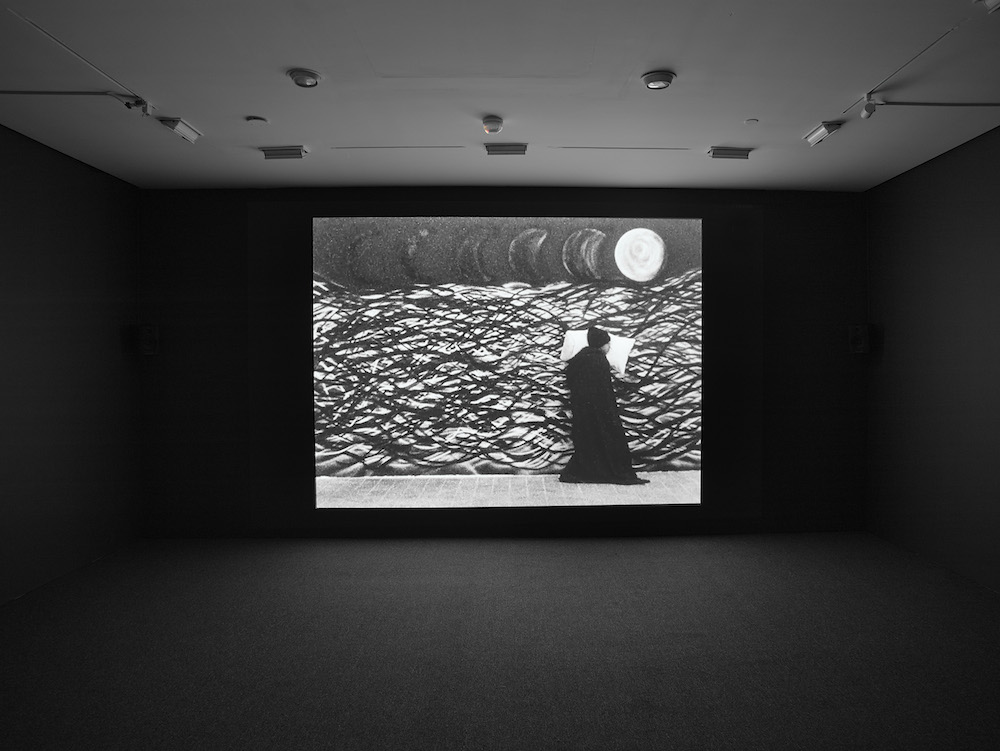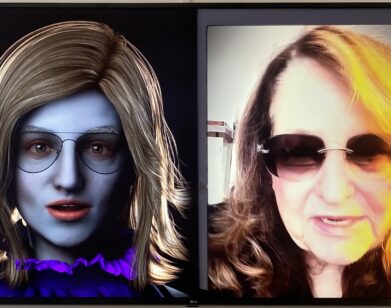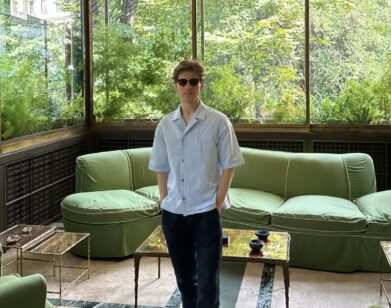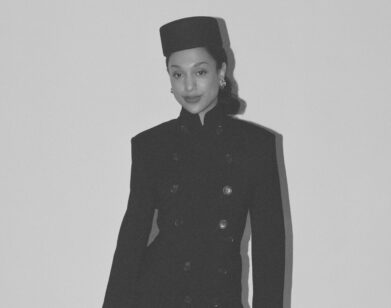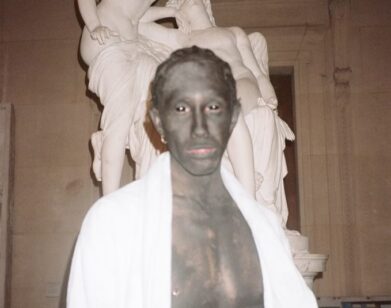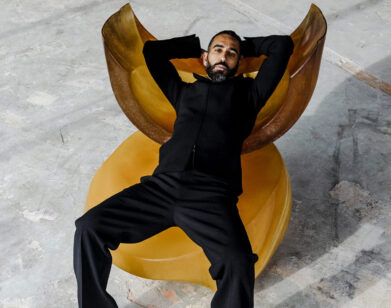Robin Rhode Considers His Past and Present
Born in Johannesburg and now based in Berlin, Robin Rhode draws from personal memories to create semi-autobiographical works of art. On the surface, his sculptural forms and accompanying drawings may appear simple, including oversized light bulbs and life-size bicycles, but each object represents a deeply rooted societal issue. In his solo show “Borne Frieze,” opening today at Lehmann Maupin in Chelsea, Rhode explores his South African heritage and the country’s current complexities through four new site-specific works, all of which exemplify his ability to blur the line between mediums and meanings.
Take for example, the work Light Giver Light Taker, in which the 39-year-old presents two sculptural light bulbs—one made of chalk, the other charcoal—sitting on the gallery floor, covered with black and white lines. Strobe lights flash in the gallery room, alternating between normal white lights and black lights to illuminate different parts of the installation. Outside of the room, a video depicts Rhode as he moved the bulbs around the floor to create the existing marks. As a whole, the work is about time, space, and memory, but also a t-shirt the artist once bought as well as South Africa’s power outages and electric rationing.
Also dealing with the absence of light, his video piece The Moon is Asleep depicts a child sleeping standing up against a black wall covered with drawings of the moon and sea, while a poem of the same name is narrated in the background by its 80-year-old author. In Evidence and Chalk Bike Rhode utilizes sculpture and wall drawings to further explore and pose questions about his own history and the trajectory of contemporary art.
Concurrent to “Borne Frieze,” Rhode will open an exhibition next month at The Drawing Center in New York, and last night he participated in a Q&A with RoseLee Goldberg, the founder of Performa. In November, as part of Performa, he will debut a commissioned rendition of Schoenberg’s opera Erwartung (Expectation) in Times Square. During the installation at Lehmann Maupin, we met with the artist to speak about the works and his process.
EMILY MCDERMOTT: I want to start with the inspiration behind this show…
ROBIN RHODE: This show’s point of inspiration is the basis of drawing. It ranges from wall drawing into the moving image and animation, and also performance. With the barbed wires in Evidence, I see it as an urban element, which has a very organic feel, as if it evokes an abstract line drawing within the installation. With the light bulbs, I did a performative action on Saturday morning, and the choreography of my interactivity with these light bulbs was scripted to the lighting effect. It shifts between the black light bulb taking light away, or is given light by the white light bulb.
MCDERMOTT: What was the starting point for Light Giver Light Taker?
RHODE: I was inspired by a t-shirt that I bought in 2007 in New Orleans. I was in a supermarket and I bought a t-shirt that said, “black inventors and their inventions,” with a list of black inventors and various graphic images of their inventions. One was the light bulb, and it said “Inventor: Lewis Latimer.” It was quite amazing, as a South African, to encounter black inventors, and to know that elements of a light bulb were patented and designed by Lewis Latimer, this African-American inventor and draftsman. That, for me, was quite profound. The idea also came from various power issues South Africa is encountering at the moment. It’s referred to as “load shedding,” where different parts of the city have to be cutoff to save electricity, to redistribute electricity—three or four hours a day, certain areas have no electricity, which means they have no light. So I was trying to create a piece where I could engage with what light could mean.
MCDERMOTT: A lot of your work reminds me a lot of Eadweard Muybridge, and those very first action photographs of horses.
RHODE: The lighting in this particular install is like that; it’s a flickering of a photographic image. It’s almost as if I want to animate the lines, to animate those very static objects through a lighting system or a kind of cinematic system.
MCDERMOTT: The bicycle is made of chalk, like the light bulb, and bikes are also a recurring part of your practice. Where does that come from?
RHODE: Initially I was inspired by a high school initiation [in South Africa]. We stole the classroom chalk and drew objects on the walls in the school, and had young kids interact with these drawings as a form of rites of passage into the high school culture. In this particular installation, the piece of chalk from the classroom has gone through a metamorphosis and has become the chalk bike, rather than the drawing of a bike. It’s almost as if it’s part ghost. What’s interesting is in parts of New York and other parts of the world, when someone is killed on a bicycle they usually have a white bike [placed in the spot where the rider died]. So it’s very much part of a memory, and it’s this homage I’m paying to my own memory of that initiation.
MCDERMOTT: Your work often deals with your personal memories.
RHODE: Exactly. It’s very biographical, yet becomes an object. And in this performance, my drawings are almost shatters of that bike. As I push the bicycle along the wall you can see the traces of where it was.
MCDERMOTT: Do you actually make these figures, or do you have them made?
RHODE: I work with a Dutch sculptor, a Dutch fabricator. We bought a metal skeletal structure of a bike before we cast various parts of the bike individually in a silicon mold. It’s quite delicate… We have these chalk windows as well, and they’re kind of reminiscent of a school classroom—it’s blackboard paint on the walls. But also, they play with this idea of exterior and interior space. Is the interior space through the windows, or are we in the interior? It’s a subtle surrealistic play on time, memory, and space.
MCDERMOTT: You had children draw on the walls for your exhibit at The Drawing Center, which you’ve done in some of your previous works as well. How do you choose if a project is going to involve children?
RHODE: It’s quite easy, because I’ve developed a wall-drawing framework, which I refer to as “Paries Pictus,” that relates to objects that can be used by children, or by various communities, to interact with the medium. For example, I didn’t conceptualize this sculpture [of the bike] to be used by the public to create a drawing. There are parameters to the wall drawings with youth; there’s a set guideline of what the template is, so it’s very basic. Then the kids pick up the oil crayons and they get a chance to then express themselves. I create the template or the guideline on which the children will then express themselves—the freedom to make marks within the confines of the visual template.
MCDERMOTT: Going back to your own childhood, when did you first become interested in art?
RHODE: I did a lot of coloring books as a kid, which is probably why I’m doing coloring books now on the walls of galleries and art institutions. [laughs] The notions of childhood for me are very important because, as artists, something we must never forget is that the most powerful ideas are the purest ideas. The purest ideas rely on the purest imagination, and children have the purest form of imagination. I’m very youth-conscious with my work, because I’m trying to search for that purity of imagination. I want to tap into that psyche that’s not tainted by reality.
MCDERMOTT: Yet you’re talking about realities.
RHODE: Yes, and to have that freedom is very important to me. As artists, we speak about freedom in so many different ways, but free from what? You’ve got to be free in your imagination to find the core idea. I think focusing on the young people and engaging with young people maintains that level of freedom.
MCDERMOTT: What do you think the core idea of your practice is becoming?
RHODE: As much as I try and run away from it, it always comes back to drawing. With this particular show, I’m exploring drawing in so many different aspects—from wall drawing, which incorporates two- and three-dimensional elements, to performative drawing.
MCDERMOTT: Can you talk about the poem that is being recited in the video?
RHODE: This is a poem written by a very famous South African poet called The Moon is Asleep. What drew me to the poem was trying to decipher light and dark. “The moon is asleep” means there is no moon, that there is a dark sky. This whole show is monochromatic—it’s black and white—so the title of this poem was in my mind. What does that mean when the moon is asleep? Is the moon sad? Is the moon covered in darkness, an eclipse? I was trying to find a formal understanding of what this title means, so I went about creating this animation without being captivated by the backstory; that came afterwards.
The poet and I are very close, he’s 80 years old, I met him some years ago, and we’ve been collaborating for some time. I’ve been engaging with his poetry a lot, because of his biography and his personal history. This poem was written to his lover that passed away in the late ’80s with HIV/AIDS. So having him narrate the piece, having the voice of an old man juxtaposed with that of a child, is something powerful and poetic. It’s very lo-fi; it’s shot on Super-8 film.
MCDERMOTT: What made you want to do that?
RHODE: I love lo-fi aesthetics. There’s a romance to Super-8 that I think is really important, and there’s nostalgia to it. When I think of Super-8 it becomes an interesting parallel to this poet’s voice. I love to work in simplistic, simple, mediums. I have my own theory of lo-fi. I say my work is lo-fi, hi-def. So I’m striving for that balance, to walk the line and say, “Okay, fine, how can I find that lo-fi [aesthetic], and still achieve a high-definitive meaning?” It’s not easy, but lo-fi, that’s my vibes.
MCDERMOTT: Can we talk about Evidence a little bit more?
RHODE: There are so many art historical references in this piece. The crucifixion, of course, strong religious symbolism, but at the same time, the depiction of the body in this position has inspired so many performance artists of the past. The skeleton was used by Duchamp; you think of Chris Burden being crucified on the Beetle; you think of Marina Abramovic as well. I’m playing with all those, the depiction of the body on the cross, yet I don’t see the body as dead.
MCDERMOTT: The skull’s chin is lifted, so it actually looks kind of alive.
RHODE: It’s suspended from the wires, too. The image I was trying to generate is the notion of suspension. With all of the hangers, I can imagine the body flying through an early Duchamp readymade and picking them up. At the same time he becomes a bird; when you see the way I positioned the hangers I think of wings, especially on the ankles. It’s like the wings of a bird.
MCDERMOTT: So I know you also used to work a lot on the streets. Has that stopped?
RHODE: No, that’s going like crazy. I have another body of work that runs parallel to these types of productions. These are studio-created pieces, something site-specific inside this interior space. But there is another body of work that runs parallel; that is my street pieces.
MCDERMOTT: Are you doing those while you’re here?
RHODE: I’ve tried to reduce the amount of street works, which I actually call “road works.” I’ve tried to reduce a lot of that output in New York because I did a lot of it over the years, and I don’t feel that same need to do it. I think sometimes the street is a trap. I feel that it’s a trap because you become almost institutionalized by the streets; people only see you as that, and the streets are even being institutionalized, because street art is mainstream like crazy. Everybody’s fucking doing street art. It’s just as institutionalized as it is in here [in the gallery]. So I don’t have a hierarchy in terms of whether I prefer the street over the gallery. I jump between all the spaces, and I’m conscious of the trappings of both—the institutionalization of the white cube and the institutionalization of the streets.
“ROBIN RHODE: BORNE FRIEZE” OPENS TONIGHT AT LEHMANN MAUPIN AND WILL BE ON VIEW THROUGH AUGUST 21. “ROBIN RHODE: DRAWING WAVES” WILL OPEN AT THE DRAWING CENTER ON JULY 17.

